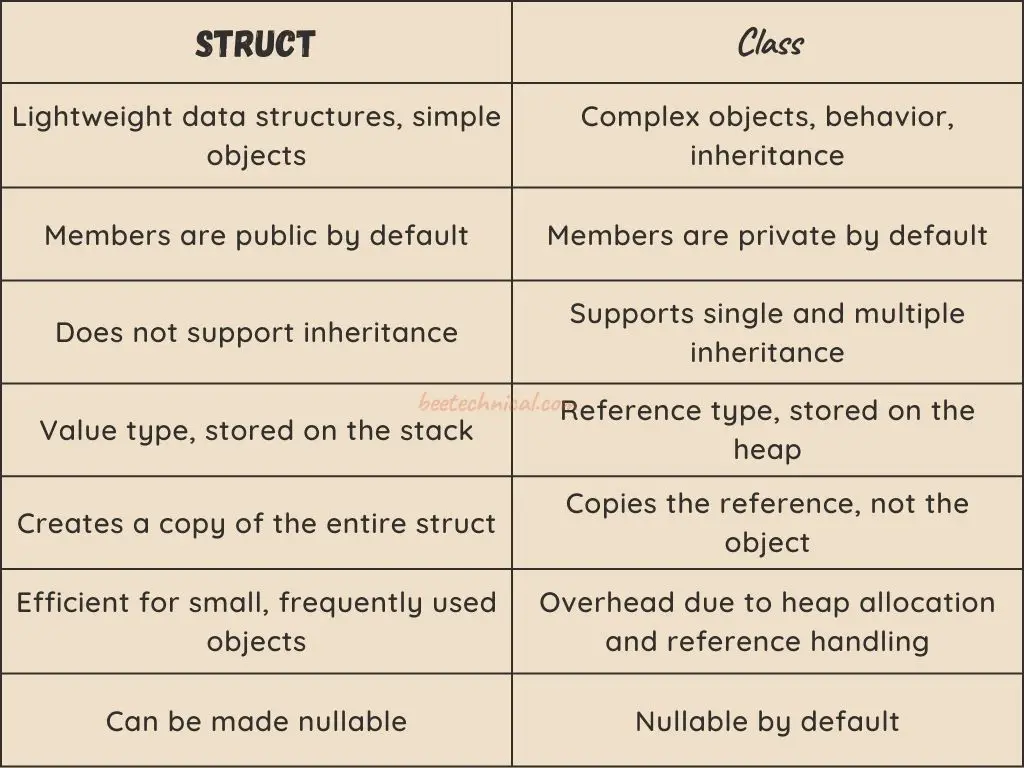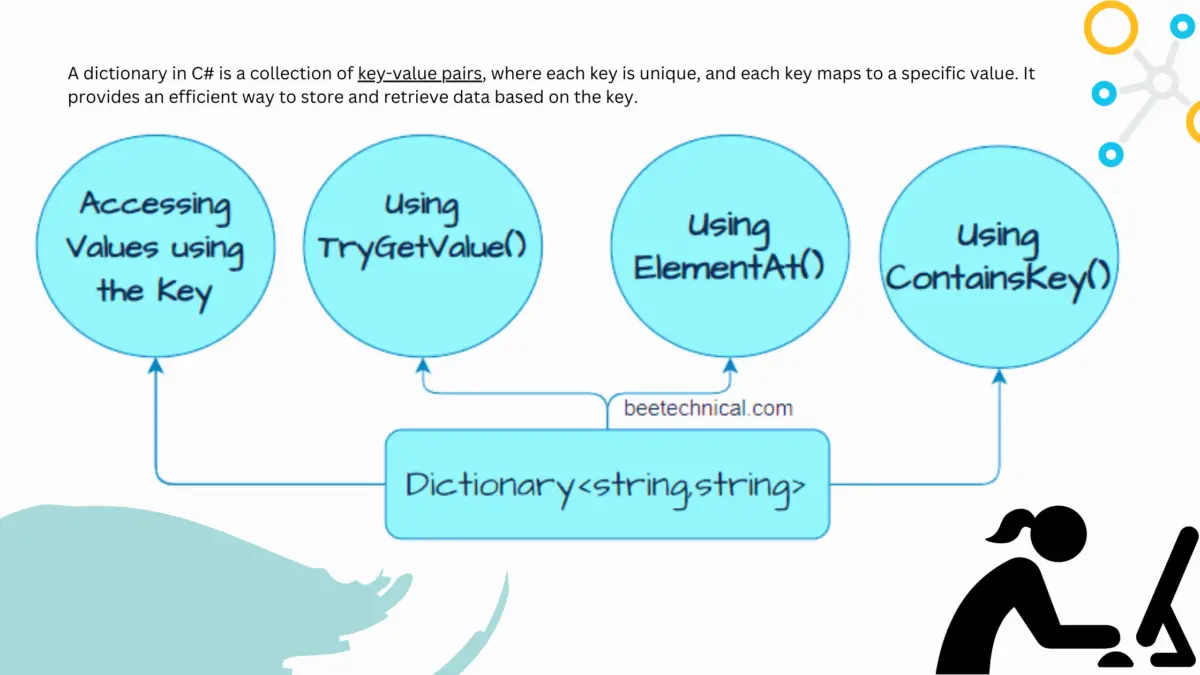When working with C# programming language, understanding the difference between class and structs is crucial.
In C#, both classes and structs are used to define custom data types, but they have some important differences. By default, members of a class are private, while members of a struct are public. Classes support inheritance, allowing one class to inherit properties and behavior from another, whereas structs do not support inheritance.
Both are the data types available in C# programing language. And, both of them have their own use cases if used wisely.
By carefully evaluating your program’s requirements, you can make an informed decision on whether to utilize a struct vs class, ensuring optimal performance and functionality.
Struct Vs Class in C#

When should I use a Struct rather than a Class?
Structs are ideal for lightweight data structures and small, immutable objects, providing performance benefits due to their value type nature and stack allocation. They are particularly useful in performance-critical scenarios and when working with interoperability requirements.
However, it’s important to consider the trade-offs, such as the lack of inheritance support and potential memory overhead for larger structs.
Real-World Example of Stuct
A real-world use case where structs are commonly employed is in financial applications, particularly when dealing with monetary values and currency calculations.
Consider a banking system that needs to handle various financial transactions, such as deposits, withdrawals, and balance calculations. In this scenario, using structs to represent currencies and financial amounts can offer several advantages.
- Efficiency: Since currency values typically consist of a fixed number of decimal places and are frequently used for calculations, representing them as structs can be more efficient than using class objects. Structs, being value types, are allocated on the stack and can be manipulated directly without the overhead of heap allocation and reference handling.
- Immutability: Financial amounts often need to maintain immutability to ensure accurate calculations and prevent unintended modifications. Structs are value types and, by default, are immutable. This immutability guarantees that once a financial amount is assigned, it cannot be changed, enhancing data integrity and preventing accidental modifications.
- Value Semantics: Structs provide value semantics, meaning that when a struct is assigned to another variable or passed as a parameter, a copy of the entire struct is created. This behavior ensures that each financial amount behaves independently, which is crucial for accurate calculations and preventing unintended side effects.
- Memory Efficiency: In financial applications, there may be a large number of financial amounts involved, such as balances, transaction values, or interest rates. Representing these amounts as structs can reduce memory overhead compared to class objects, especially when dealing with a large volume of transactions or account balances.
By utilizing structs in financial applications, developers can achieve efficient and accurate handling of financial amounts, optimize memory usage, and maintain data integrity throughout the system.
using System;
// Struct representing a currency amount
struct Currency
{
public decimal Amount;
public string Symbol;
}
class Program
{
static void Main()
{
// Create currency instances
Currency usd = new Currency { Amount = 1000.50m, Symbol = "$" };
Currency eur = new Currency { Amount = 750.75m, Symbol = "€" };
// Display currency amounts
Console.WriteLine("USD: " + usd.Amount + usd.Symbol);
Console.WriteLine("EUR: " + eur.Amount + eur.Symbol);
// Perform currency conversion
decimal conversionRate = 0.85m; // 1 USD = 0.85 EUR
Currency convertedAmount = ConvertCurrency(usd, conversionRate);
// Display converted currency amount
Console.WriteLine("Converted Amount: " + convertedAmount.Amount + convertedAmount.Symbol);
// Keep the console window open
Console.ReadKey();
}
// Convert currency amount based on the conversion rate
static Currency ConvertCurrency(Currency currency, decimal conversionRate)
{
Currency convertedCurrency = currency;
convertedCurrency.Amount *= conversionRate;
return convertedCurrency;
}
}
Real-World Example of Class
A real-world example where a class is typically used and a struct cannot be used is modeling a customer in an e-commerce system. Let’s consider the following scenario:
In an e-commerce system, a customer is a complex entity that contains various properties and behaviors. Each customer has a unique identifier, a name, a shipping address, an email address, a list of past orders, and methods for placing orders, updating information, and interacting with the system.
In this case, a class is more suitable for modeling a customer because:
- Complex Structure: A customer is a complex entity with multiple properties and behaviors. Using a class allows you to encapsulate these properties and behaviors within a single entity, enabling the representation of the customer’s state and supporting various operations.
- Mutability and Behavior: Customers’ information and state can change over time. With a class, you can define methods to update customer details, place orders, and perform other actions. Classes support mutable properties and behavior, making it easier to handle dynamic changes and interactions within the system.
- Relationships and Associations: Customers often have relationships with other entities, such as orders, payment methods, and loyalty programs. Classes allow you to define these relationships using references and enable interactions and associations between different instances.
- Inheritance and Extensibility: If you need to extend the customer functionality, such as creating specialized customer types (e.g., VIP customers), implementing additional interfaces, or introducing specific behaviors, classes support inheritance, interfaces, and other mechanisms for extensibility.
- Object Identity and Reference Semantics: Customers are typically identified and referred to by their unique identifiers. Classes’ reference semantics allow multiple references to point to the same customer instance, ensuring object identity and facilitating tracking and management across the system.
While a struct provides value semantics and efficiency benefits, it may not be suitable for modeling a customer entity in this scenario due to its limited capabilities in terms of behavior, mutability, relationships, and extensibility.
A class provides a more flexible and appropriate approach to represent and manipulate the complex and evolving nature of a customer within an e-commerce system.
using System;
using System.Collections.Generic;
class Customer
{
public int CustomerId { get; set; }
public string Name { get; set; }
public string ShippingAddress { get; set; }
public string Email { get; set; }
public List<Order> Orders { get; set; }
public void PlaceOrder(Order order)
{
Orders.Add(order);
Console.WriteLine($"Order {order.OrderId} placed by {Name}");
}
}
class Order
{
private static int nextOrderId = 1;
public int OrderId { get; }
public decimal TotalAmount { get; set; }
public Order(decimal totalAmount)
{
OrderId = nextOrderId++;
TotalAmount = totalAmount;
}
}
class Program
{
static void Main()
{
// Create customers
Customer customer1 = new Customer { CustomerId = 1, Name = "John Doe", ShippingAddress = "123 Main St", Email = "[email protected]", Orders = new List<Order>() };
Customer customer2 = new Customer { CustomerId = 2, Name = "Jane Smith", ShippingAddress = "456 Elm St", Email = "[email protected]", Orders = new List<Order>() };
// Create orders
Order order1 = new Order(99.99m);
Order order2 = new Order(149.99m);
// Place orders
customer1.PlaceOrder(order1);
customer2.PlaceOrder(order2);
// Display customer details and orders
Console.WriteLine($"Customer: {customer1.Name}, Orders: {customer1.Orders.Count}");
Console.WriteLine($"Customer: {customer2.Name}, Orders: {customer2.Orders.Count}");
// Keep the console window open
Console.ReadKey();
}
}
Conclusion
By carefully considering your program’s needs, you can make an informed decision on whether to use a struct or a class. Each has its own strengths and trade-offs, so it’s essential to choose the one that best aligns with your specific use case to ensure optimal performance, maintainability, and functionality.
Frequently Asked Questions
Can a struct be null in C#?
By default, structs in C# cannot be null. Structs are value types and are not nullable. However, you can use the nullable value type feature introduced in C# 2.0 to make a struct nullable by appending a ‘?’ after its type declaration (e.g., int?). This allows you to assign a null value to the nullable struct.
Can a struct have methods in C#?
Yes, a struct in C# can have methods. Structs can have both instance methods and static methods, just like classes. However, it’s important to note that methods in a struct should not mutate the struct’s state, as structs are typically used for representing immutable data.
Can structs inherit from other structs or classes in C#?
No, structs in C# cannot inherit from other structs or classes. Structs do not support the inheritance or implementation of interfaces. They are meant to be simple, self-contained data structures and cannot participate in an inheritance hierarchy.
Can I use properties and events in a struct?
Yes, you can use properties and events in a struct in C#. Structs can have properties with get and set accessors, and they can also have event declarations and event handlers. However, it’s important to consider the performance implications of using properties and events instructs, as they can potentially increase memory usage and impact performance due to copying behavior.









Comments are closed.